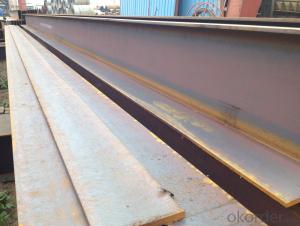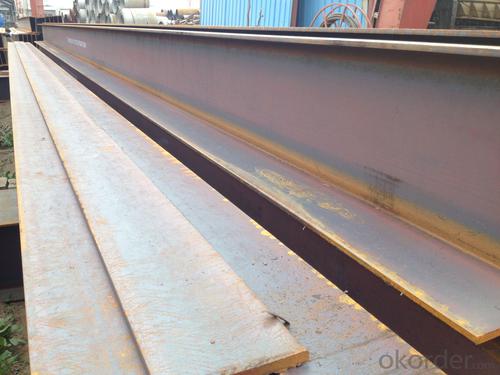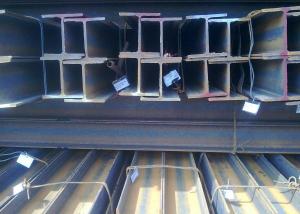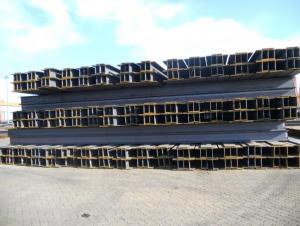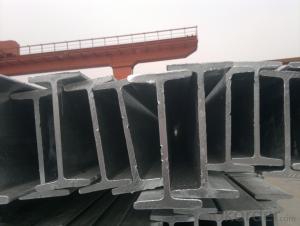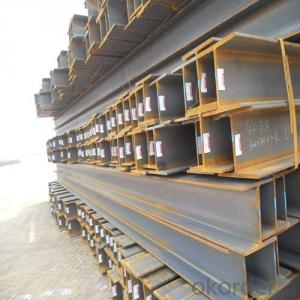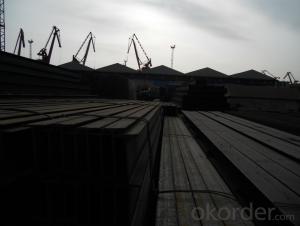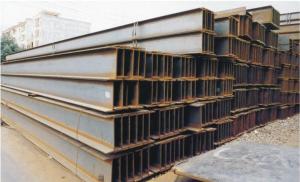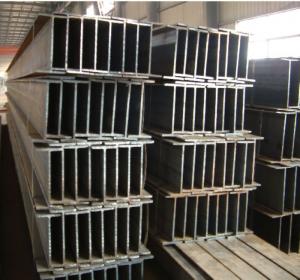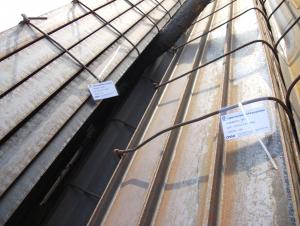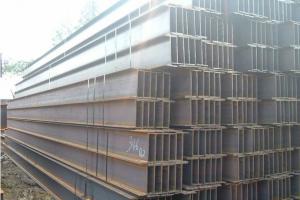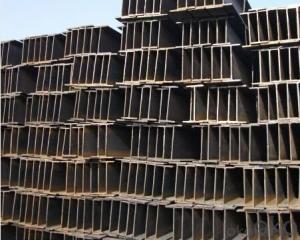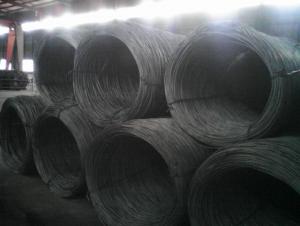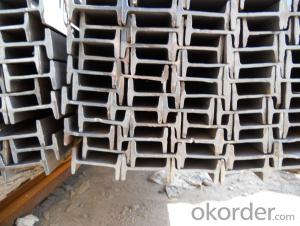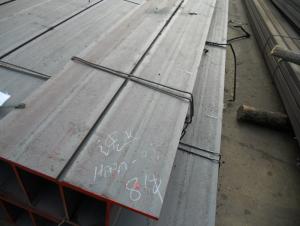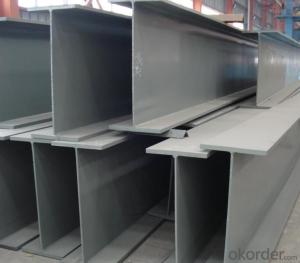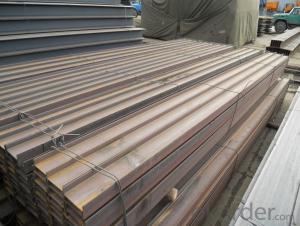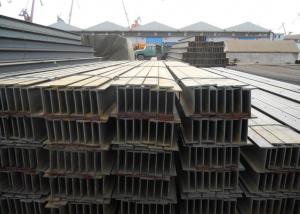Hot Rolled Structural Steel H Beam
- Loading Port:
- China Main Port
- Payment Terms:
- TT or LC
- Min Order Qty:
- 100 m.t.
- Supply Capability:
- 10000 m.t./month
OKorder Service Pledge
OKorder Financial Service
You Might Also Like
Product Description:
OKorder is offering Hot Rolled Structural Steel H Beam at great prices with worldwide shipping. Our supplier is a world-class manufacturer of steel, with our products utilized the world over. OKorder annually supplies products to African, South American and Asian markets. We provide quotations within 24 hours of receiving an inquiry and guarantee competitive prices.
Product Applications:
Hot Rolled Structural Steel H Beam are ideal for structural applications and are widely used in the plant, high-rise building construction, the bridge, shipment building, lifting and transportation machinery, equipment manufacturing base building, the support, foundation pile manufacturing etc.
Product Advantages:
OKorder'sHot Rolled Structural Steel H Beam are durable, strong, and wide variety of sizes.
Main Product Features:
· Premium quality
· Prompt delivery & seaworthy packing (30 days after receiving deposit)
· Can be recycled and reused
· Mill test certification
· Professional Service
· Competitive pricing
Product Specifications:
Grade: SS400, Q235
Standard: JIS G3101, GB STANDARD
Payment: T/Tor L/C AT SIGHT
Technique: Hot Rolled
Package: Packed in bundles and shipped by break bulk or containers.
| H BEAM | ||||||
| size | h (MM) | b (MM) | t1 (MM) | t2 (MM) | Mass: Kg/m | LENGTH |
| 100x100 | 100 | 100 | 6.0 | 8 | 16.9 | 12M |
| 125x125 | 125 | 125 | 6.5 | 9 | 23.6 | 12M |
| 150x75 | 150 | 75 | 5.0 | 7 | 14.0 | 12M |
| 148x100 | 148 | 100 | 6.0 | 9 | 20.7 | 12M |
| 150x150 | 150 | 150 | 7.0 | 10 | 31.1 | 12M |
| 175x90 | 175 | 90 | 5.0 | 8 | 18.0 | 12M |
| 175x175 | 175 | 175 | 5.0 | 11 | 40.4 | 12M |
| 198x99 | 198 | 99 | 4.5 | 7 | 17.8 | 12M |
| 200x100 | 200 | 100 | 5.5 | 8 | 20.9 | 12M |
| 194x150 | 194 | 150 | 6.0 | 9 | 29.9 | 12M |
| 200x200 | 200 | 200 | 8.0 | 12 | 49.9 | 12M |
| 200x204 | 200 | 204 | 12.0 | 12 | 56.2 | 12M |
| 248x124 | 248 | 124 | 5.0 | 8 | 25.1 | 12M |
| 250x125 | 250 | 125 | 6.0 | 9 | 29.0 | 12M |
| 244x175 | 244 | 175 | 7.0 | 11 | 43.6 | 12M |
| 250x250 | 250 | 250 | 9.0 | 14 | 71.8 | 12M |
| 250x255 | 250 | 255 | 14.0 | 14 | 81.6 | 12M |
| 298x149 | 298 | 149 | 5.5 | 8 | 32.0 | 12M |
| 300x150 | 300 | 150 | 6.5 | 9 | 36.7 | 12M |
| 294x200 | 294 | 200 | 8.0 | 12 | 55.8 | 12M |
| 294x302 | 294 | 302 | 12.0 | 12 | 83.4 | 12M |
| 300x300 | 300 | 300 | 10.0 | 15 | 93.0 | 12M |
| 350x175 | 350 | 175 | 7.0 | 11 | 49.4 | 12M |
| 340x250 | 340 | 250 | 9.0 | 14 | 78.1 | 12M |
| 344x348 | 344 | 348 | 10.0 | 16 | 113.0 | 12M |
| 350x350 | 350 | 350 | 12.0 | 19 | 135.0 | 12M |
FAQ:
Q1: Why buy Materials & Equipment from OKorder.com?
A1: All products offered byOKorder.com are carefully selected from China's most reliable manufacturing enterprises. Through its ISO certifications, OKorder.com adheres to the highest standards and a commitment to supply chain safety and customer satisfaction.
Q2: How do we guarantee the quality of our products?
A2: We have established an advanced quality management system which conducts strict quality tests at every step, from raw materials to the final product. At the same time, we provide extensive follow-up service assurances as required.
Q3: How soon can we receive the product after purchase?
A3: Within three days of placing an order, we will arrange production. The normal sizes with the normal grade can be produced within one month. The specific shipping date is dependent upon international and government factors, the delivery to international main port about 45-60days.
Images:
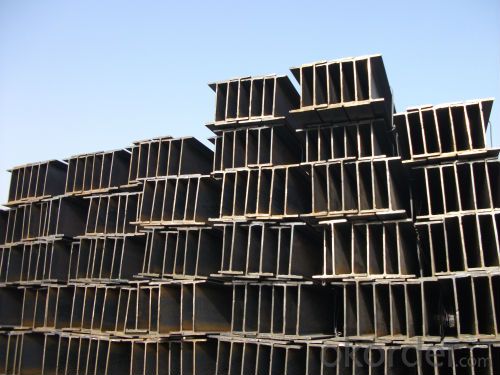
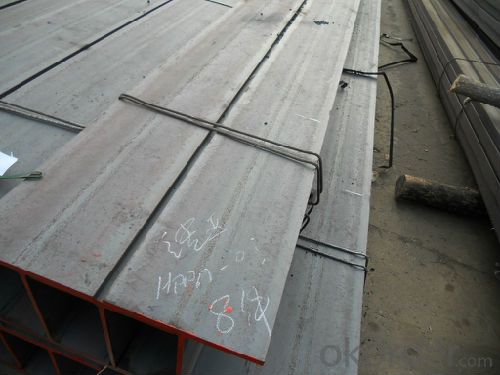
- Q: Can steel H-beams be used in utility infrastructure projects?
- Certainly, utility infrastructure projects can employ steel H-beams. The strength and durability of steel H-beams make them a popular choice in construction. Their ability to bear heavy loads and provide structural support makes them particularly suitable for utility infrastructure projects. H-beams find extensive use in the construction of large structures like bridges and buildings, making them an excellent option for utility infrastructure projects such as power plants, water treatment plants, and transmission towers. Moreover, steel H-beams display resilience against harsh weather conditions and can endure natural disasters like earthquakes and hurricanes, rendering them a trustworthy choice for long-term utility infrastructure projects.
- Q: What are the different welding techniques used for steel H-beams?
- There are several welding techniques commonly used for steel H-beams. These techniques include: 1. Arc Welding: This is the most common welding technique used for steel H-beams. It involves the use of an electric arc between an electrode and the base metal to create the weld. Arc welding can be further divided into several sub-categories, such as shielded metal arc welding (SMAW), gas metal arc welding (GMAW), and flux-cored arc welding (FCAW). Each of these sub-categories has its own advantages and disadvantages, and the choice of technique depends on factors such as the thickness of the steel and the desired weld quality. 2. Gas Tungsten Arc Welding (GTAW): Also known as TIG (tungsten inert gas) welding, this technique uses a non-consumable tungsten electrode to create the weld. A separate filler metal is usually added to the weld pool manually. GTAW is known for its high-quality welds and is often used for applications that require precision and aesthetic appeal. 3. Submerged Arc Welding (SAW): This technique involves the use of a continuously fed wire electrode and a granular flux that covers the weld area. The arc is maintained below a layer of flux, which protects the weld from atmospheric contamination. SAW is commonly used for welding thick steel sections and is known for its high deposition rate and deep penetration. 4. Laser Beam Welding (LBW): This technique uses a highly focused laser beam to create the weld. LBW is known for its high precision and narrow heat-affected zone, making it suitable for welding thin steel H-beams. However, it is a relatively expensive technique and requires specialized equipment. The choice of welding technique for steel H-beams depends on various factors such as the thickness of the steel, the desired weld quality, production volume, and available equipment. Each technique has its own advantages and limitations, and it is important to select the most appropriate technique based on the specific requirements of the project.
- Q: Do steel H-beams require special maintenance?
- Special maintenance is not usually necessary for steel H-beams. Nevertheless, it is recommended to conduct regular inspections and maintenance to guarantee their structural soundness and long lifespan. This entails promptly addressing any signs of corrosion or damage, such as cracks or bends. Furthermore, it is important to keep the H-beams clean and clear of debris or excessive moisture in order to prevent corrosion and maintain their overall state. Ultimately, despite the renowned durability and strength of steel H-beams, regular maintenance is crucial to ensure their ongoing performance and safety.
- Q: How do steel H-beams contribute to the overall flexibility and adaptability of a structure?
- Steel H-beams contribute to the overall flexibility and adaptability of a structure by providing a strong and versatile structural support system. These beams can be easily modified or resized to meet the changing needs of a building or structure. Additionally, their high strength-to-weight ratio allows for longer spans and greater load-bearing capacity, enabling architects and engineers to design more flexible spaces and accommodate various layout changes.
- Q: How do steel H-beams compare to other structural beams?
- Steel H-beams are widely regarded as one of the most efficient and effective structural beams available. They offer several advantages over other types of beams, including their high strength-to-weight ratio, versatility, and cost-effectiveness. Firstly, the high strength-to-weight ratio of steel H-beams makes them incredibly strong and durable while also being relatively lightweight. This allows for the construction of large and complex structures without adding excessive weight, reducing the overall cost and making them easier to transport and install. In addition, steel H-beams have a unique shape that provides excellent load-bearing capabilities. The H shape distributes the weight evenly along the beam, allowing it to support heavy loads and resist bending or twisting. This makes them ideal for use in structures that require long spans or heavy loads, such as bridges, skyscrapers, and industrial buildings. Furthermore, steel H-beams are highly versatile and adaptable. They can be easily customized and fabricated to meet specific design requirements, allowing for the creation of structures of various shapes and sizes. Additionally, they can be joined together using welding or bolting methods, providing flexibility during construction and allowing for modifications or extensions in the future. Another advantage of steel H-beams is their cost-effectiveness. While initial costs may be higher compared to some other materials, the long-term benefits outweigh the investment. Steel is highly durable and resistant to corrosion, reducing maintenance and replacement costs over time. Moreover, its recyclability makes it an environmentally friendly choice. Overall, steel H-beams offer numerous advantages over other structural beams, including their high strength-to-weight ratio, versatility, and cost-effectiveness. These factors make them a popular choice in various construction projects and contribute to their widespread use in the industry.
- Q: How do steel H-beams resist corrosion?
- Steel H-beams are able to resist corrosion by combining the properties of steel with protective coatings. The high strength and durability of steel make it naturally resistant to corrosion. Chromium and nickel, which are elements found in steel, contribute to its corrosion resistance by forming a protective oxide layer on the surface. This layer acts as a barrier to prevent further corrosion. To further enhance durability and longevity, H-beams are often coated with protective materials. This can include zinc galvanization, where the steel beam is immersed in molten zinc to create a protective layer. Epoxy or polyurethane-based paints can also be used to create a barrier between the steel and the environment. Regular maintenance and inspection are important in preventing corrosion. Any signs of coating damage should be addressed promptly to protect the underlying steel. Regular cleaning and removal of dirt or debris also help maintain the integrity of the protective coating. In conclusion, steel H-beams resist corrosion due to the properties of steel, protective coatings, and proper maintenance. These measures ensure that the H-beams can withstand environmental conditions and maintain their structural integrity over time.
- Q: What is the lifespan of a steel H-beam in outdoor applications?
- The lifespan of a steel H-beam in outdoor applications can differ based on several factors. Initially, the durability and grade of the steel utilized in the H-beam will have a significant impact on its longevity. Steels of superior quality with appropriate corrosion-resistant coatings can endure outdoor conditions for a lengthier duration. Moreover, environmental conditions like exposure to moisture, extreme temperatures, and corrosive substances such as saltwater or chemicals can affect the H-beam's lifespan. Consistent maintenance and proper protective measures, such as the application of anti-corrosion coatings or galvanization, can considerably prolong the H-beam's lifespan in such surroundings. Besides, the load-bearing capacity and structural integrity of the H-beam should be taken into account to ensure its ability to withstand any potential stress or external forces it may encounter throughout its lifespan. Correct design, installation, and regular inspections are essential for maintaining the structural integrity and longevity of the H-beam in outdoor applications. In general, providing an exact lifespan for a steel H-beam in outdoor applications is challenging, as it relies on various aforementioned factors. However, with appropriate material selection, consistent maintenance, and protective measures, a steel H-beam can endure for numerous decades in outdoor applications.
- Q: Are steel H-beams suitable for use in the construction of airports or terminals?
- Yes, steel H-beams are an appropriate choice for the construction of airports or terminals. With their strength and durability, steel H-beams are frequently utilized as structural components in construction. They are specifically designed to withstand heavy loads and provide stability to various structures. Airports and terminals necessitate robust structural elements that can support large spans, accommodate heavy machinery, and endure the dynamic loads imposed by aircraft. Steel H-beams possess the capability to fulfill these requirements, making them an ideal selection for such construction projects. Moreover, steel H-beams offer several advantages over alternative materials. They possess fire-resistant properties, boast an extended lifespan, and require minimal maintenance. These qualities render them a cost-effective option in the long run. Furthermore, steel H-beams can be easily fabricated and erected, facilitating efficient construction timelines. Their versatility allows for flexibility in design, enabling architects and engineers to devise tailored solutions to meet the specific demands of airports or terminals. To summarize, steel H-beams are suitable for the construction of airports or terminals due to their strength, durability, fire resistance, and low maintenance requirements. They provide a cost-effective and efficient solution for creating stable and reliable structures that can withstand the demands of these facilities.
- Q: What are the uses of I-beam and H steel?
- The flange of the I-beam is variable cross section, the thickness of the web is thin and the outside is thin. The flange of H section steel is equal section
- Q: Are steel H-beams suitable for power plants?
- Yes, steel H-beams are often suitable for power plants due to their strength and durability. Power plants typically require large and robust structures to support heavy equipment and withstand extreme conditions. Steel H-beams are known for their high load-bearing capacity and resistance to bending, making them a popular choice for power plant construction. H-beams are designed to distribute weight evenly and efficiently, allowing them to support heavy machinery and equipment found in power plants, such as generators, boilers, and turbines. Their shape, with a wider flange and a thinner web, provides excellent stability and structural integrity, making them suitable for withstanding the dynamic loads and vibrations common in power plant operations. Additionally, steel H-beams can be fabricated to meet specific design requirements and can be easily assembled, allowing for quick and efficient construction. This is crucial for power plants, as they often have strict deadlines and need to be operational as soon as possible. Furthermore, steel H-beams have excellent resistance to corrosion, which is essential in a power plant environment where exposure to moisture, chemicals, and high temperatures is common. This ensures the longevity and reliability of the structural components. In summary, steel H-beams are suitable for power plants due to their strength, load-bearing capacity, stability, and resistance to corrosion. Their ability to support heavy equipment, withstand extreme conditions, and provide efficient construction makes them a preferred choice for power plant construction projects.
Send your message to us
Hot Rolled Structural Steel H Beam
- Loading Port:
- China Main Port
- Payment Terms:
- TT or LC
- Min Order Qty:
- 100 m.t.
- Supply Capability:
- 10000 m.t./month
OKorder Service Pledge
OKorder Financial Service
Similar products
Hot products
Hot Searches
Related keywords
